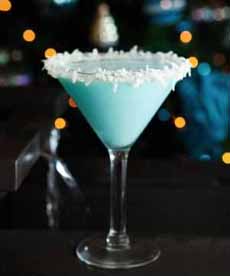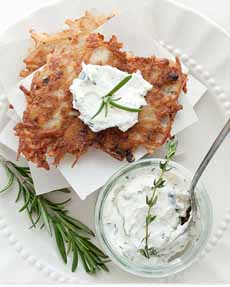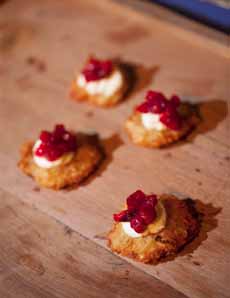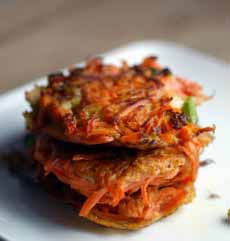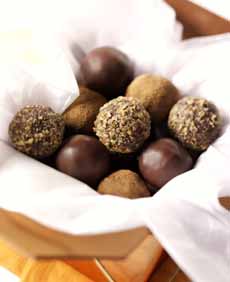
[1] Crones, small rhizomes (photo courtesy Sid Wainer).

[2] Crosnes serve as the roots of this flowering plant (photo Wikipedia).

[3] Close-up (photo courtesy Cuisinons Les Legumes.
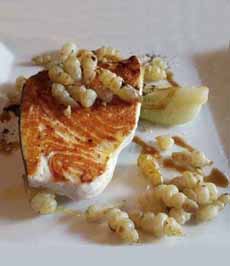
[4] Crosnes with grilled swordfish at Il Goto | Paris).
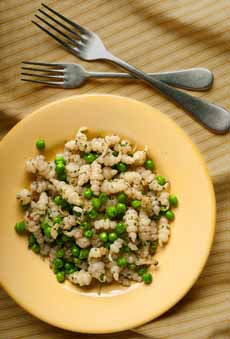
[5] Crosnes and peas. Here’s the recipe from Honest-Food.net, photo Holly A. Heyser).
|
|
Do you know about crosnes (pronounced crones)?
We didn’t until about a year ago, when they were served to us as a main course vegetable at Petrossian in New York City.
From the order Lamiales, the botanical family Lamiaceae, commonly known as the mint or deadnettle family, has lots of flowering plants, many of them aromatic.
The family includes culinary herbs such as basil, hyssop, lavender, marjoram, mint, oregano, perilla, rosemary, sage, savory and thyme.
But there are other family members that don’t fit in that group. One interesting member is crosnes (photo #1), pearly little tubers, the root of the plant.
WHAT ARE CROSNES?
Crosnes are rhizomes, edible roots of a flowering plant (photo #2). Crosnes have the unique look of larvae (photo #3) (as does malloreddus pasta from Sardinia), which can be cool or creepy, depending on your disposition.
It is an aesthetic perspective: Chinese poets have compared crosnes to jade beads.
They are harvested in the fall, like potatoes (which have similar nutrition but are from a different order, Solanales, and family, Solanaceae).
The name references the French town of Crosne, a suburb of Paris. The root was brought to the area by local chefs returning from travel through Eastern Asia, in the 1800s.
Local farmers grew the crop as something of a delicacy, and the vegetable was quite fashionable across Europe for some time, before declining in fashion (source).
Depending on how they’re cooked, crosnes are crunchy, with a flavor and texture reminiscent of water chestnuts (order Poales, family Cyperaceae or jerusalem artichokes (order Asterales, family Asteraceae).
(We provide this botanical information to illustrate that vegetables that may seem to be related actually have no kinship at all. )
Originating in China, crosnes (genus and species Stachys affinis) are also known as Chinese artichoke, Japanese artichoke, artichoke and knotroot.
The thin skin ranges from a pale beige to ivory white in color, with white flesh inside. It is not peeled before cooking. The nutty flavor is delicate.
HOW TO SERVE CROSNES
Crosnes can be prepared similarly to poratoes Jerusalem artichokes; but they require extra soakings and brushings to remove all the dirt from the small, convoluted shapes.
Crosnes are used as a general vegetable or starch, in salads, and as a very interesting garnish.
If you like crunchy veggies, you can lightly blanch them; otherwise, cook them more thoroughly.
In French cuisine, crosnes often sautéed in butter. An alternative: olive oil and garlic.
They work with just about any sauce, spice or other seasoning. The knots and ridges catch sauces beautifully, like corkscrew pasta.
Roast them, or add them to stir-fries.
Eat them raw, like mini carrots.
We deep-fried them, like French fries—fun, if pricey, fries.
In Japan, they’re tempura battered and fried.
Use them as a garnish: whole, halved or shredded.
In China and Japan, they are pickled as a snack and condiment.
For the Japanese New Year (Lunar New Year, Chinese New Year), they are pickled and then dyed red with red shiso leaves (the result is called chorogi).
Crosnes may be hard to find at conventional grocers. You’re more likely to find them at specialty suppliers, which sell to fine restaurants. You may also find them at farmers markets (with the farmers who grow them for the restaurants).
Oh…and since so few farmers grow them in the U.S., they can cost up to $40 a pound at retail.
Once the tubers have been dug up, they begin to dry out. Store them in a plastic bag in the fridge and plan to use them in a day or two.
Crosnes should be white and firm to the touch. If they’re limp or dull in color, pass them by.
And if you’re dining out and find them on your plate, you know what they are!
RECIPES
Crosnes and Peas (photo #5)
Goat Cheese & Crosnes Salad
Sauteed Crosnes With Fines Herbes
Snapper with Truffled Favas and Crosnes
|




